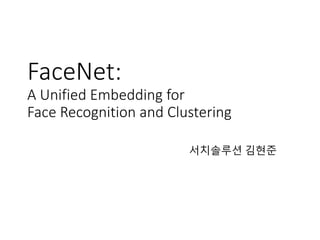FaceNet: A Unified Embedding for Face Recognition and Clustering
•Descargar como PPTX, PDF•
2 recomendaciones•3,444 vistas
구글에서 공개한 FaceNet을 설명한다.
Denunciar
Compartir
Denunciar
Compartir

Recomendados
Recomendados
Más contenido relacionado
La actualidad más candente
La actualidad más candente (20)
StyleCLIP: Text-Driven Manipulation of StyleGAN Imagery 

StyleCLIP: Text-Driven Manipulation of StyleGAN Imagery
Deep Learning for Computer Vision: Data Augmentation (UPC 2016)

Deep Learning for Computer Vision: Data Augmentation (UPC 2016)
Intuitive & Scalable Hyperparameter Tuning with Apache Spark + Fugue

Intuitive & Scalable Hyperparameter Tuning with Apache Spark + Fugue
DeepWalk: Online Learning of Social Representations

DeepWalk: Online Learning of Social Representations
Deep learning for_extreme_multi-label_text_classification

Deep learning for_extreme_multi-label_text_classification
Semi-Supervised Classification with Graph Convolutional Networks @ICLR2017読み会

Semi-Supervised Classification with Graph Convolutional Networks @ICLR2017読み会
PR-284: End-to-End Object Detection with Transformers(DETR)

PR-284: End-to-End Object Detection with Transformers(DETR)
Similar a FaceNet: A Unified Embedding for Face Recognition and Clustering
Similar a FaceNet: A Unified Embedding for Face Recognition and Clustering (11)
Deep neural networks cnn rnn_ae_some practical techniques

Deep neural networks cnn rnn_ae_some practical techniques
FaceNet: A Unified Embedding for Face Recognition and Clustering
- 1. FaceNet: A Unified Embedding for Face Recognition and Clustering 서치솔루션 김현준
- 2. Goal of FaceNet • 다음을 만족하는 임베딩 함수를 찾는다 • Invariant • 표정, 조명, 얼굴 포즈 … • 같은 사람의 얼굴 임베딩은 가깝다 • 다른 사람의 얼굴 임베딩은 멀다
- 3. Goal of FaceNet • 다음을 만족하는 임베딩 함수를 찾는다 • Invariant • 표정, 조명, 얼굴 포즈 … • 같은 사람의 얼굴 임베딩은 가깝다 • 다른 사람의 얼굴 임베딩은 멀다 • 이미 잘 되는 분야 아닌가?
- 4. Previous Works • 얼굴 인식용 네트워크 • bottleneck layer의 벡터 사용 • 간접적 • Loss function은 분류에 대해 정의됨 • 벡터가 우리가 원하는 특성을 갖는다는 보장이 없다 • 비효율적 • 모르는 얼굴에 대해서도 잘 동작할까? • 큰 사이즈 (1000s of dimension) • 기타 노력들 • PCA로 벡터 축소 • 3D alignment • Classification & Verification loss 혼합
- 5. FaceNet의 특징 • 작은 벡터 • 128D • 원하는 임베딩 벡터의 특징을 바로 학습 • Triplet loss • 같으면 가까워지고 다르면 멀어져라 • 복잡한 alignment가 필요 없다 • Scale, translation만 적용 • 많은 데이터로 invariance 특징을 학습함 • Data-driven • End-to-end
- 6. 적용 분야 • Face verification • 두 장의 사진이 같은/다른 사람이냐 • Face classification • 가장 가까운 얼굴로 분류 • Nearest Neighbor • Face clustering • 임베딩이 Euclidean distance에 존재 • 기존 클러스터링 그대로 적용 가능
- 7. Triplet Loss • 세 개의 데이터 • Anchor (𝑥 𝑎): 기준 얼굴 • Positive (𝑥 𝑝 ): 기준과 같은 인물의 얼굴 • Negative (𝑥 𝑛): 기준과 다른 인물의 얼굴 • 같으면 가까워지고 다르면 멀어져라
- 8. Triplet Loss (Cont’) • 우리의 바램 • Anchor와 Negative의 거리가 • Anchor와 Positive의 거리보다 • 최소한 𝛼만큼 멀리 있으면 좋겠다
- 9. Triplet Loss (Cont’) • 우리의 바램 • Anchor와 Negative의 거리가 • Anchor와 Positive의 거리보다 • 최소한 𝛼만큼 멀리 있으면 좋겠다 • 수식
- 10. Triplet Loss (Cont’) • Loss • Hinge Loss: [𝑥]+= max(0, 𝑥) • Margin 최대화 • Constraint: • Euclidean space • d-dimensional hypersphere • 𝛼=0.2로 고정
- 11. Triplet Selection • 두 명의 사람이 각각 10장의 사진을 가질 때 가능한 triplet 의 수 • #사람 X #Anchor X #Positive #Negative • 2 X 10 X 9 X 10 = 1800 • 대량의 학습데이터에서는 • 너무 많은 triplet의 수 • 전부 학습에 도움이 되는 건 아니다
- 12. Triplet Selection (Cont’) • 학습에 도움이 되는 triplet을 골라보자 • 어려운 문제를 풀수록 배우는게 많겠지? • Hard positive: 가장 멀리 있는 positive • Hard negative: 가장 가까이 있는 negative • Mini-batch에서 골라보자 • 사이즈: 1,800 • 매 step마다 모든 데이터를 뒤질 수는 없지 • 잘못 레이블 된 데이터를 피할 수 있다 • 모든 데이터를 뒤질 경우 찾는 것: • Hard positive: 다른 사람인데 같은 이름이 붙은 사진 • Hard negative: 같은 사람인데 다른 이름이 붙은 사진
- 13. Triplet Selection (Cont’) • 학습 디테일 • Mini-batch에 약 40개의 identity • Hard-positive 안씀 • 모든 positive 사용 • 안정적인 학습 • 초반에 약간 빠른 수렴 • 학습 초반에 Hard-negative는 너무 어렵다 • Local minima에 빠짐 • 좀 더 쉬운 Semi-hard 사용 • Anchor와 positive를 정한 뒤 positive보다 먼 negative 선택 • Positive와 거리가 비슷해서 hard라고 말할 수 있다
- 14. Models • Category 1 • Zeiler&Fergus 기반 모델 • 1x1 convolution 추가 • NN1 • Category 2 • GoogleNet 기반 모델 • NN1과 비교 • 약 20배 적은 파라미터 • 최대 5배까지 적은 계산 량 • NN2~4 • 입력 크기: 220x220, 160x160, 96x96 • NNS1~4 • 모바일을 위한 작은 모델들
- 15. NN2 architecture
- 16. NN2 architecture 𝐿2 Pooling 왜 𝐿2 Pooling 일까? 왜 저 자리일까? 아무 언급 없음
- 17. Experiments • Train dataset: Unknown • Test datasets: 자체 DB • Hold-out test set • Personal photos • Evaluation • Cross validation • Test dataset로 부터 Same/Diff의 threshold d 학습 • Validation rate: VAL(d) • 같은 사람을 같다고 예측한 비율 • False accept rate: FAR(d) • 다른 사람을 같다고 예측한 비율
- 18. FLOPS vs. Accuracy trade-off Evaluated on Personal Photos dataset
- 19. And the others Image quality (NN1, hold-out DB) Embedding Dimensionality (NN1, hold-out DB) Training data size (NN2 변형)
- 20. Experiments (Cont’) • Test datasets • LFW • YouTube Faces Database • Evaluation • Cross validation • Test dataset로 부터 Same/Diff의 threshold d 학습 • Train/validation set은 DB에서 지정
- 21. Experiments (Cont’) • LFW • 고정된 영역 crop: 98.87%±0.15 • Detect & align: 99.63%±0.09 13 pair중 5개는 잘못된 레이블
- 22. Experiments (Cont’) • YouTube Faces Database • 95.12%±0.39 • 처음 1000개의 프레임만 사용 • 95.18%
- 23. Thank you!